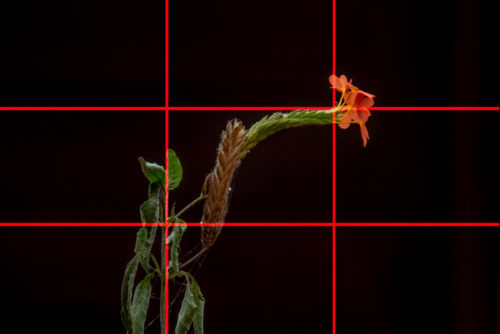
The Rule of Thirds one of the first things that budding digital photographers learn about in composition on photography. Many thank this rule for their well balanced and interesting shots. However, that rules are meant to be broken and ignoring this one doesn’t mean your images are necessarily unbalanced or uninteresting. As a quote which is misattributed to Pablo Picasso says, “Learn the rules like a pro, so you can break them like an artist.” 🙂

The basic principle behind the rule of thirds is to imagine breaking an image down into thirds (both horizontally and vertically) so that you have 9 parts as “tic tac toe” grid. The four intersections of the grid are the points that you should consider placing points of interest in as you frame your image. It also gives you four ‘lines’ that are also useful positions for elements in your photo as I did in the photo above. You can check the grid overlay in the photo above.


The theory is that if you place points of interest in the intersections or along the lines that your photo becomes more balanced and will enable a viewer of the image to interact with it more naturally. Studies have shown that when viewing images that people’s eyes usually go to one of the intersection points most naturally rather than the centre of the shot – using the rule of thirds works with this natural way of viewing an image rather than working against it. The top left intersection is supposed to attract 40% of the viewer’s attention. So having the “eye” of the subject there makes a definite attraction.
Using the Rule of Thirds comes naturally to some photographers but for many of us takes a little time and practice for it to become second nature.
Placing the subject in the rule of thirds intersection takes little practice. Let us say you started off by placing the subject in the centre of the frame and focusing on the subject’s eye. Instead of having a boring shot with your subject in the dead centre, you could place the subject a little to the side at the intersection of thirds and end up with a much better composition.


Such recompose is quite easy to accomplish. Place the eye of the subject at the central focus point and attain good focus. Hold the shutter button in half shutter (this locks the focus) and the recompose so that subject eye is in the intersection of the thirds as you want it. Once you are satisfied with the placement, click the shutter fully to capture.
In learning how to use the rule of thirds (and then to break it) the most important questions to be asking of yourself are:
- What are the points of interest in this shot?
- Where am I intentionally placing them?
Once again – remember that breaking the rule can result in some striking shots – so once you’ve learnt it experiment with purposely breaking it to see what you discover.


Lastly – keep the rule of thirds in mind as you edit your photos later. Post-production editing tools like Adobe Lightroom and Photoshop crop tools allow you to use the rule of thirds overlay for cropping and reframing images so that they fit within the rules.
If you like to know more about Rule of Thirds, check this blog – Beginners Guide to Rule of Thirds in Photography


Wonderfully explained Sir, I will always get confused in this part. Thanks for the detail explaintion and the Fab Quote.
Thank you sir, very informative and easy to understand
Nice simple way of explaining the profound rule of composition which gives the image a zing Dr. Krishi